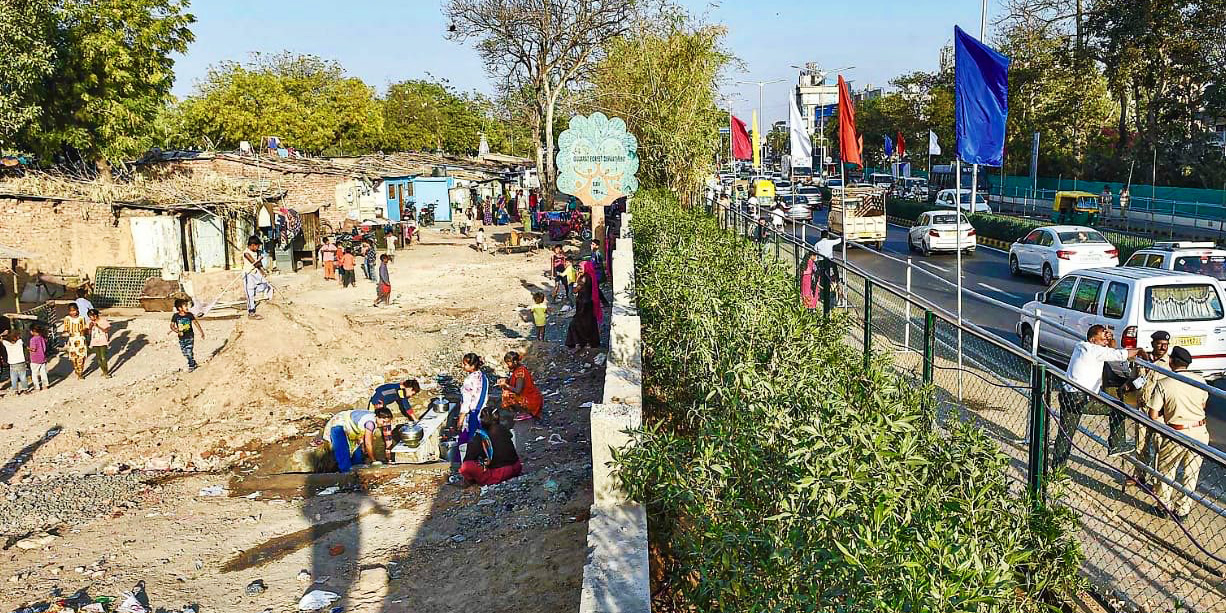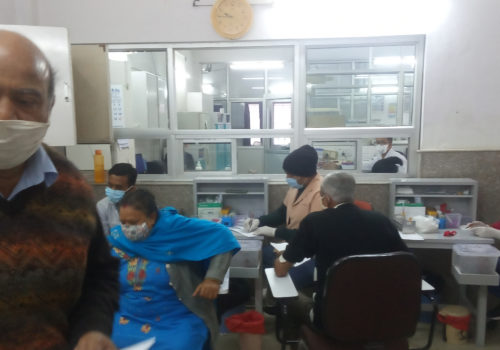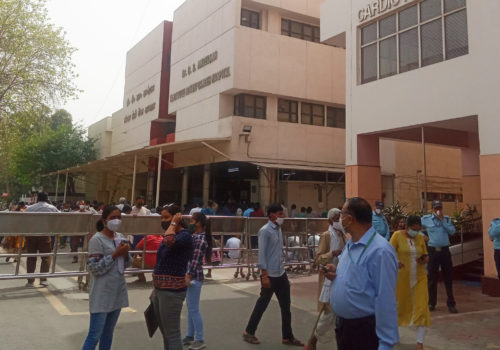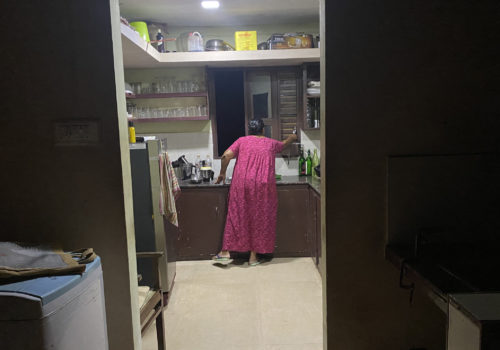DELHI — In February 2020, just before the coronavirus pandemic gripped the world, India was preparing for a two-day visit by the US president, Donald Trump, to the western state of Gujarat. Ahead of his arrival, the city of Ahmedabad erected a 1,640-foot brick wall along a road where the president’s convoy was likely to pass. It was painted emerald green and embellished with “Namaste Trump” slogans, sealing off from view a large slum that stood on the other side, where more than 2,000 people lived. Another 45 families were evicted from huts that stood near the stadium hosting the event before being demolished. “Why are they hiding us poor people?” Keshi Saraniya, one of the slum residents, asked in a report by the Associated Press.
The wall’s construction prompted critics to point to Narendra Modi’s once-touted “Gujarat model of development” during his 12-year-long tenure as the state’s chief minister. “Instead of accepting the failure of its model, the Modi government has decided to hide it,” wrote a former deputy mayor. “But these walls are not enough to hide the reality.”
Under Modi’s leadership in 2001 to 2014, Gujarat saw a massive boost in infrastructure with new highways and airports built and 24-hour electricity made available in all cities and villages. It came with a string of business-friendly policies providing tax concessions and subsidies for corporate investments, attracting major companies like Tata Motors and Ford. Officials used the term “the Gujarat model” synonymously with “development,” arguing that over the long term, a strong economy would deliver benefits to the general population. Gujarat was branded as a model for 21st-century India, seen as the cornerstone for Modi’s rise to national prominence before he became the country’s prime minister in 2014.
But despite the much-publicized efforts to stimulate economic growth, the project came in for public criticism. On the Human Development Index, Gujarat still ranked near the bottom, with poverty and open-defecation rife even in urban areas. When compared to most other states, critics said, minimal spending on healthcare and education exacerbated inequality. “When people say Gujarat was a successful economic model, they overlook the fact that in terms of undernourishment, illiteracy and lack of immunization, Gujarat has one of the worst records,” the economist and Nobel laureate Amartya Sen told the national daily Hindustan Times.
So when the brutal second wave of the coronavirus came to India earlier this year, it came as little surprise that Gujarat’s health care system began to crumble. So far, it has officially registered more than 21 million infections and 9,000 deaths. In early April, the state’s fatality rate was 7.88 percent, nearly twice the national average and the highest in the country, with several reports suggesting the number of deaths was even higher due to undercounting. Among rural communities, a lack of access to basic medical treatment worsened the public health crisis. Just as the plight of the poor was once hidden behind a concrete wall, the full extent of the pandemic’s devastation in Gujarat’s small towns and villages is concealed behind inaccurate official data. But it is already laying bare the failures under Modi’s rule.
* * *
Arvind Khuman is a 41-year-old lawyer in Rajula, a small town on the coast of the Arabian Sea, where fishing is the main source of local income. Last April, Covid cases were virtually non-existent in his community, but unemployment and hunger soared after a nationwide lockdown was imposed with just four hours’ notice, leading to a huge loss of income for daily wage workers. Since then, Khuman has been driving up and down the coast to distribute food and supplies to villagers on behalf of international NGOs.
Last February, when many speculated that the worst was over after the first wave of the pandemic had subsided and the government relaxed Covid restrictions, mass public gatherings began taking place in many parts of the country. In Khuman’s district, local elections were in full swing. Political parties campaigned across the state, and voting occurred in over six phases. “That’s when we started seeing corona spread because so many politicians came to campaign here and traveled from district to district,” Khuman said.
In the weeks that followed, cases skyrocketed across Gujarat, which has a population of 60 million people. The infection first spread in cities: Ahmedabad accounted for nearly 74 percent of total cases and 80 percent of fatalities. Then the virus moved into the 18,000 villages spread over 33 districts, where there is a severe shortage of doctors and other medical personnel. Nine districts, including Khuman’s Amreli, where Rajula is located, showed no signs of cases stabilizing. Amreli recorded between 100 and 200 positive cases on a daily basis in May, with a test positivity rate that wavered between 10 and 20 percent, a trend that worried many health officials. The district had 10 designated hospitals for Covid treatment, but within a single week in May, at least three no longer had a single vacant bed with oxygen supplies.
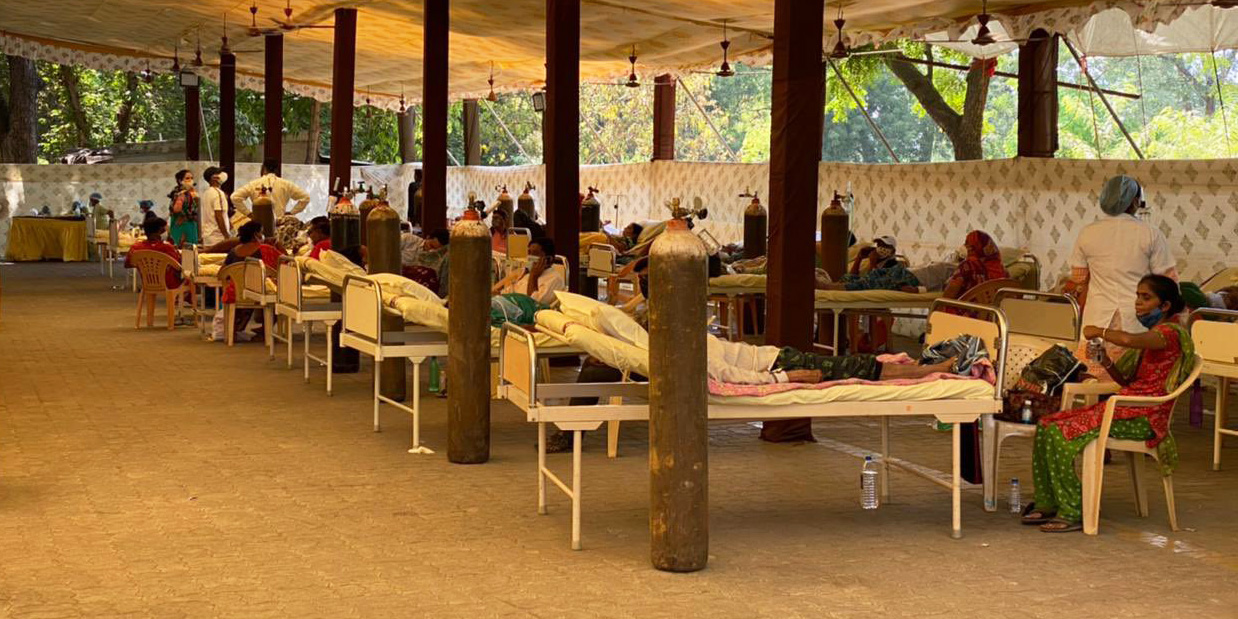
The conditions were worse in villages. Many districts in Gujarat have a single primary health center, also known as PHCs, for eight to 10 neighboring villages. Some of these centers had no personal protective gear or rapid testing kits, let alone Covid treatment facilities. “If people get sick, they usually stay at home to try and get better, or they have to travel long distances to get to the nearest hospital,” Khuman said.
A week ago, Khuman visited the family of a 27-year-old man in the village of Lodhpur who began showing Covid symptoms. There was no testing available to confirm he had Covid, and the man chose to stay home. “Whatever happens to me will happen here, I don’t want to go to the hospital,” he told his parents. Khuman suspects the family was both worried about the stigma attached to the illness and unable to afford hospital treatment. When the man’s condition deteriorated, he was finally taken to the nearest primary health center, where a nurse told his family to go to a Covid hospital immediately. He died on his way there. His two elderly parents say they are devastated by his death, but grateful he got to spend his last days in the comfort of his own home. “What could have changed even if we had reached the hospital?” the father said, “It was already full.”
Even before the pandemic, Gujarat had 0.33 hospital beds for every 1,000 people, compared to a national average of 0.55 beds per 1,000. Sanjeev Kumar, a researcher at the Tata Institute of Social Sciences, found that the total number of primary health centers in rural Gujarat was less than even Bihar, the state with the worst ratio of hospital beds in the country.
The failure to build a robust public health infrastructure has been matched by a decline in education spending, which is less than 2 percent of the state’s annual income. Nearly half of the Gujarati workforce is illiterate, with over 90 percent of workers in informal and traditional sectors with low incomes and low social security, according to the International Labor Organization. Consequently, when Covid cases began climbing in rural areas by mid-May, the government finally organized a two-week program called “Maru Gam, Corona Mukt Gam” (My village, Covid-free village), where over 15,000 care centers would be set up in 14,000 local villages to isolate suspected cases.
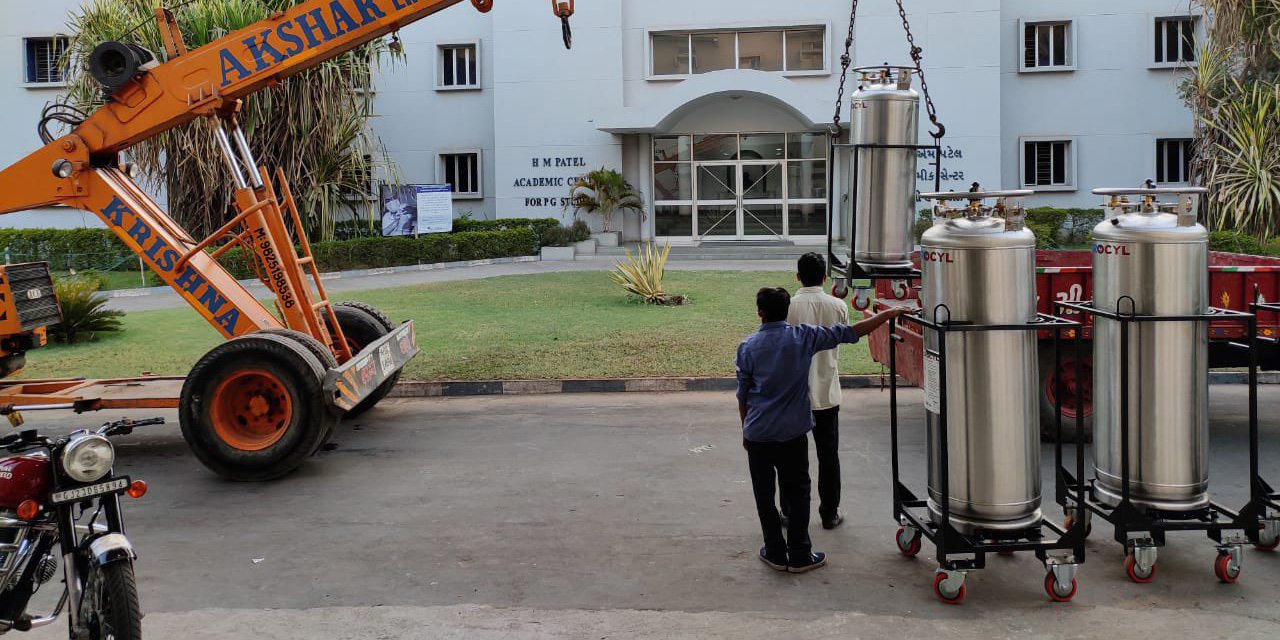
However, like the 27-year-old man who died on his way to the hospital, many villagers are still hesitant or unable to get medical help. Twenty-one-year-old Daksh Patel lives in Vardhari, a village with a population of just 400 in the district of Mahisagar. Patel said many residents in his village are showing Covid symptoms but are not getting tested. He estimates there have been at least a hundred deaths in the second wave so far. “It’s a huge number for a village with such a small demographic,” said Patel, who is currently recovering from Covid himself. The primary health center in his village is shut, and the nearest hospital is refusing patients from other counties, he said, which means residents need to travel 16 miles to the nearest city to get tested. “The situation is overwhelming, people are so scared,” he said.
The man who died belonged to a Scheduled Caste, which stands at the bottom of the hierarchy in the Hindu caste system, so his parents buried him in the land nearby and draped a saffron cloth over his grave. Since he didn’t test for Covid and the family didn’t register a death certificate, it’s likely he will never be counted as a Covid fatality in official data.
With dismal testing in rural areas, the scale of the virus is anyone’s guess.
* * *
Accounting for the full scale of the Covid-19 crisis in Gujarat is an uphill battle. For the past three months, reports and images of long queues at hospitals and crematoriums have filled the pages of local Gujarati papers, with reporters manually counting bodies and comparing the numbers to the official Covid-19 data that the government releases every evening.
While the pace of infections and deaths has slowed down recently, a sharp mismatch in official numbers still exists. To confirm the discrepancy, experts have gathered anecdotal evidence through local reports, obituaries and death certificates. In a little over two months, there were at least 40,000 “excess deaths” in the state over the previous years’ data, around 10 times the official Covid death count during this period, according to a local report by Ashish Gupta, a demographer at the University of Pennsylvania, and Murad Banaji, a mathematician at Middlesex University London.
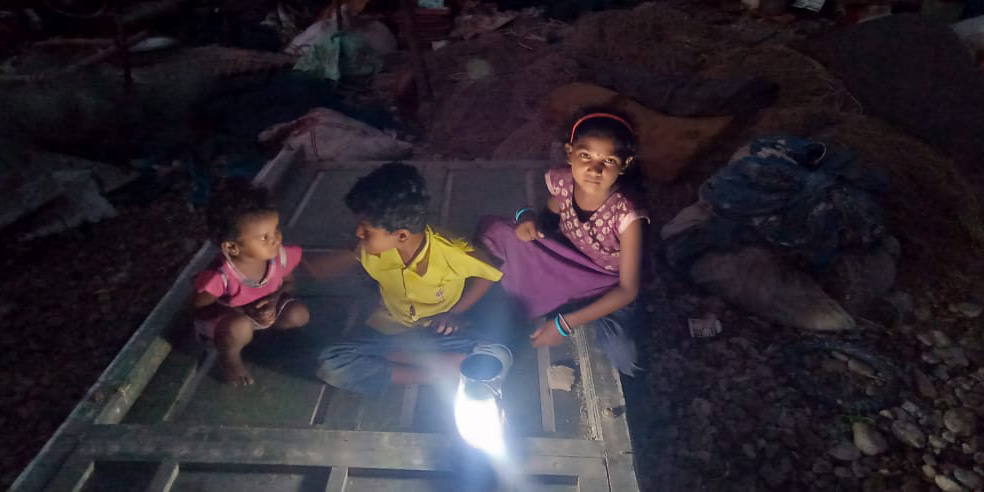
As India slowly recovers from Covid-19 cases, the western states of Gujarat and Maharashtra have simultaneously seen a rise in cases from a rare, deadly infection called mucormycosis, also known as “black fungus.” Doctors believe there is a link between the infection and the steroids used to treat Covid, with patients becoming sick 12 to 18 days after recovering from Covid. With over 2,000 patients and 250 deaths in Gujarat—the highest in the country—the state government has declared it an epidemic. In public hospitals in the cities of Ahmedabad, Surat and Rajkot, special wards have been set up, with nearly all beds filled up with black fungus patients.
Amid the raging pandemic, India’s western coast has also been hit by another crisis: In late May, Cyclone Tuktae made landfall in Maharashtra and Gujarat, with heavy rains and gusty winds ravaging coastal areas. Close to 200,000 people were evacuated as homes were damaged and trees and electricity poles uprooted. At least 75 people lost their lives, including seven in Gujarat. Vaccination drives were also suspended, and Covid patients admitted to hospitals along the path of the cyclone were shifted to safer facilities.
In Rajula, Khuman has diverted his attention from helping Covid patients to those who have lost their livelihoods in the cyclone. Although the government’s disaster relief scheme will provide cyclone victims with some support, they will still need assistance to recover from their losses. Khuman has been distributing water and food: “That’s their first need,” he said. The houses in the villages near the river have collapsed and crops in the fields have been completely destroyed. Currently, fishermen are trying to sort through the wreckage to find their boats in the hope of salvaging some of their fishing equipment. In one house, one fisherman’s wife just kept crying. “Everything is ruined, we have nothing left,” she told Khuman.
With multiple disasters ravaging the state, how much the Gujarat model of development has helped its people is questionable. Lalit Khambataya, a special correspondent for the local newspaper Gujarat Samachar, believes the model has only helped businesses and improved infrastructure like roads and highways. When it comes to the pandemic, he said, he could point only to an emergency helpline that “certainly saved lives” by enabling Covid patients to be transported to hospitals in ambulances. “The model doesn’t really exist beyond that for health emergencies,” he said.
But Somashekhar Nimbalkar, a pediatrician at Shree Krishna hospital, the largest rural hospital near the city of Ahmedabad, believes the government is doing its best given the model’s limitations. At his hospital, Covid facilities have been ramped up from 100 hospital beds to 500. A makeshift facility was set up under a large tent in the parking lot with an in-house oxygen plant, and beds and ventilators were immediately taken up by patients. Of the 500 beds, Nimbalkar says, the cost of at least 400 will be covered by the local government. Similarly, the public health center in his small town of Anand has been actively tracing Covid patients. When Nimbalkar’s own children tested positive, the center called him twice to ask if he needed any assistance. “The people here will never give up,” he said.
But for the villagers in Rajula, Khuman said there is only one word to describe how they are feeling: “mayoos,” referring to despair and sorrow. “First they saw the Covid situation and then the cyclone. They are beyond caring, they are completely broken.”
Top photo: A newly built wall blocks the view of a slum area in Ahmedabad ahead of President Trump’s visit (@RanaAyyub)

